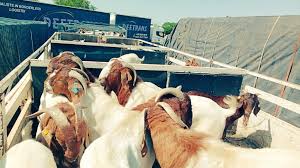Couple thrives in Boer goat farming
The couple pioneered the commercialised goat farming in 2018 and are among the few Boer goat rearers in Matabeleland North province.
A Boer goat is a breed that was developed in South Africa in the early 1900s and is a popular breed for meat production.
They are also used for milk production.
Their name is derived from the Afrikaans word boer, meaning farmer. In many cases a Boer goat has a white beard and brown head and some males may reach 160kg and females can reach 110kg.
In Zimbabwe Boer goats are popular in Matabeleland South particularly in Gwanda and Beitbridge.
The Mugombas started with 20 goats in 2018 and the herd has grown to 60 after they sold some to breeders.
Theirs is a pure breed and is kept separately from ordinary goats for breeding. Mr Mugomba and his wife are based in Sikabelo resettlement area in Woodlands outside Victoria Falls and keep the goats on a piece of land that Mr Mugomba inherited from his grandfather in 2018.
“I do livestock, crop farming and horticulture. My herd is still growing and I have 25 head of cattle, 40 sheep and 60 Boer goats. I started with ordinary goats and in 2018 I got 20 Boer goats from Bulawayo.
They could be more by now had I not sold some to other breeders,” said Mr Mugomba.
He said he keeps his Boer goats separately from the ordinary ones.
“I keep them separately from all others and they are guarded every moment as I don’t want them to mix otherwise the breed will be compromised,” he said.
The Boer goats are free grazers like any other goats but because they are big they need supplementary feeding especially in winter.
A fully grownBoer goat can weigh as much as 160kg.
Mr Mugomba said he has sold some young males for as much as US$150 each and US$90 for females, but a fully grown Boer goat can fetch as much as US$500.
He said the goats need special care.
“We are the only ones with Boer goats here and we work very closely with the Veterinary Services Department here in Victoria Falls and we make sure they have enough water and pasture but generally they are not prone to diseases,” said Mr Mugomba.
The Mugombas are also breeding Afrikander cattle and growing crops on their piece of land.
Afrikander cow They have benefitted from the Presidential Input Scheme over the years and this year
they planted maize, sugar beans, groundnuts and sunflower under Intwasa scheme.
Mr Mugomba said despite the poor rains this year, he expects to harvest 30 tonnes of maize.
“This year has not been good because of less rains but we expect a good harvest of between 25 and 30 tonnes of maize because we planted early and we have started harvesting,” he said.
They also do market gardening and grow various kinds of vegetables which they sell to the surrounding community and hospitality industry.
Intwasa scheme
They have sunk a borehole for reliable water supply for domestic use; irrigation and watering their livestock.
Woodlands is within a wildlife area and farmers in the community take turns to guard fields and livestock.
Mr Mugomba said farming is the cornerstone for the country’s aspirations for an upper middle income society status by 2030.
“Farming is the way to go if we are to realise our goals. If we get enough Government help for those farming in conservancies like Woodlands we will be assured of realising our vision for an upper middle income society. For now we are working on diversifying our farming.
“Covid-19 has taught us that we need more than one source of income to survive and as for us while we are also into tourism, we were not seriously affected because we quickly switched to farming and started supplying vegetables when the pandemic hit the industry,” he said. — The Chronicle











